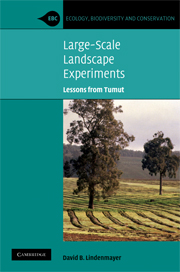Book contents
- Frontmatter
- Contents
- Preface
- Acknowledgements
- 1 The science of understanding landscape change: setting the scene for the Tumut Fragmentation Study
- 2 The theory: an overview of landscape change and habitat fragmentation
- 3 The field laboratory: the Tumut study area and the vertebrate animals it supports
- 4 Setting up the study: the design and implementation of the main cross-sectional study at Tumut
- 5 The core findings: the effects of landscape context on animals and plants
- 6 Patch use: how animals use patches of remnant eucalypt forest surrounded by pine
- 7 Theory against data: testing ecological theories and concepts
- 8 Testing PVA models with real data: melding demographic work with population modelling
- 9 Genes in the landscape: integrating genetic and demographic analyses
- 10 Refining and extending the research programme: additional studies at Tumut (and nearby) that build on the Fragmentation Study
- 11 Recommendations for plantation managers: implications for biodiversity and conservation in plantations
- 12 Lessons on running large-scale research studies: some insights from running the Tumut Fragmentation Study and directions for the future
- Appendix 1 List of collaborators/contributors to the Tumut Fragmentation Experiment
- Appendix 2 Detections of bird species in the Tumut Fragmentation Study classified by four broad classes of sites
- References
- Index
5 - The core findings: the effects of landscape context on animals and plants
Published online by Cambridge University Press: 20 May 2010
- Frontmatter
- Contents
- Preface
- Acknowledgements
- 1 The science of understanding landscape change: setting the scene for the Tumut Fragmentation Study
- 2 The theory: an overview of landscape change and habitat fragmentation
- 3 The field laboratory: the Tumut study area and the vertebrate animals it supports
- 4 Setting up the study: the design and implementation of the main cross-sectional study at Tumut
- 5 The core findings: the effects of landscape context on animals and plants
- 6 Patch use: how animals use patches of remnant eucalypt forest surrounded by pine
- 7 Theory against data: testing ecological theories and concepts
- 8 Testing PVA models with real data: melding demographic work with population modelling
- 9 Genes in the landscape: integrating genetic and demographic analyses
- 10 Refining and extending the research programme: additional studies at Tumut (and nearby) that build on the Fragmentation Study
- 11 Recommendations for plantation managers: implications for biodiversity and conservation in plantations
- 12 Lessons on running large-scale research studies: some insights from running the Tumut Fragmentation Study and directions for the future
- Appendix 1 List of collaborators/contributors to the Tumut Fragmentation Experiment
- Appendix 2 Detections of bird species in the Tumut Fragmentation Study classified by four broad classes of sites
- References
- Index
Summary
This chapter summarises the results of studies of landscape context effects for nine groups of animals and plants. The description of findings for each group is preceded by an outline of how each group was surveyed – the counting method and the number of sites surveyed was different in each case. The final part of this chapter contrasts the results for different groups and reflects on the main lessons of the work.
Survey methods
All empirical studies of landscape change and habitat fragmentation are underpinned by the quality of the field data gathered. Data quality is, in turn, influenced by the field methods employed. Failure to consider the efficacy of such methods may mean that what are perceived to be the effects of landscape change and habitat fragmentation are, in fact, artefacts of the field survey techniques.
A sub-theme at Tumut was therefore to test the accuracy and effectiveness of methods for sampling the major groups of vertebrates targeted in the study, particularly terrestrial mammals, birds and arboreal marsupials. These data were used to assist in the interpretation of field data or to modify field counting protocols to ensure that the best quality data were gathered. In addition, different methods and/or different subsets of the 166 sites were surveyed to estimate presence, abundance or cover. For example, it was logistically impossible to survey all 166 sites for invertebrates and bryophytes, and hence a subset of sites was selected.
- Type
- Chapter
- Information
- Large-Scale Landscape ExperimentsLessons from Tumut, pp. 97 - 122Publisher: Cambridge University PressPrint publication year: 2009



